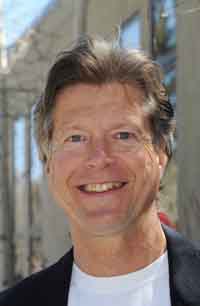"Breathe in thinking, 'My body is strong.' Breathe out thinking, 'My mind is at peace.'"
If these words are familiar to you, then you are one of thousands of people who have attended a yoga class with Richard Odom. These words mark the end of every class Odom teaches. One of Odom's students, an Army Special Forces soldier, says these words every time he has to jump out of an airplane.
Odom began teaching yoga in the Wood River Valley in the mid-1970s, long before it exploded in popularity. He provided early instruction to actress and author Mariel Hemingway, tennis pro John McEnroe and local yogi Ryan Redman.
"Keep breathing," he said recently during a one-hour class at the Wood River YMCA. "If you are not breathing, you are not doing yoga. You may be doing something, but it's not yoga."
Odom is a self-taught yogi who emphasizes self-knowledge over received ideas; he trusts in the "wisdom of the body" to lead yoga practitioners to what they need and don't need from yoga. He once advised McEnroe to relax between points during a match to preserve his energy.
"He told me he was afraid of losing his killer instinct," says Odom. "And he was right. John had to go to tournaments and regularly beat everyone in the world. Yoga changes your priorities. Practicing it may make it less important to go out and beat everyone in the world."
Odom grew up in Daytona Beach, Fla. His parents were theosophists who kept a vast library of books, journals and magazines. They shared their broad interest in the world's cultural traditions with Odom and his two sisters.
"We learned early on that there was more than one way to the truth," he says.
When he was 13, Odom read books by Yesudian Selvarajan and Alain Danielou and was introduced to the sages, seers and hermits of the East. Today he is more likely to quote Krishnamurti and Alan Watts to explain yoga.
"There was nothing spiritual about it when I began practicing. I was simply addressing adolescent feelings of insecurity. I hoped it would help me pick up chicks, maybe be a better athlete or student."
Odom practiced alone, forcing himself into the postures illustrated in his books, even wedging himself under the furniture in his house to get into position.
"I did anything I could do to make it work. It was a love-hate relationship, even claustrophobic. It was like zipping myself into a rubber suit, but I also discovered a sense of calm in the postures."
<
Odom became an avid bodysurfer, sometimes taking on the steep waves delivered up by the Atlantic Ocean. One day the waves were quite large and Odom found himself pinned down unexpectedly by an undertow. Instead of going into a panic, he flashed back on the yoga postures he had been practicing. He became calm and found he could hold his breath for a very long time.
"After a while, I made my way across the sea bottom and then the wave spit me out. I burst free and felt this incredible sense of awe. I could see the ocean spray and the sunshine in a new way. I heard the sounds of kids on the beach and the seagulls. I was absolutely on top of the world. I realized that this was the power of yoga, but there was nobody in my town to share the experience with."
Odom went back to his books about Eastern traditions to find parallels with his own experience. He also studied martial arts, attended West Point for a year and then graduated from Florida State University with a degree in history and philosophy. After practicing alone for many years, he offered a yoga class for the first time in Ketchum more than 30 years ago. He spent five years in the Bikram (heat yoga) tradition, but eventually developed his own teaching practice, one that is light on philosophy, big on floor poses and often humorous.
"I'm real practical. I don't assume anything works just because someone else says it is so."
Odom is the author of "Yoga—Eastern vs. Western Philosophy," a chapter in the latest edition of "Fitness: Theory and Practice," a textbook for aerobics and fitness professionals. In it he describes the four major aspects of traditional Yoga: Raja Yoga (the physical aspect), Jnana Yoga (intellectual pursuits), Bhakti Yoga (religious devotion) and Karma Yoga (good works).
Odom—who focuses on the Raja aspect—says practitioners need to listen to their bodies.
"Yoga is a practice of stripping away, of the mind learning from the body rather than the body learning from the mind. The body has a wisdom that has evolved for 80,000 years. The mind still has not evolved to the point where it knows the difference between something that is really happening and something that is happening only in our heads.
" ... The body is ready and waiting to unfold everything you need. Yoga attempts to get you to one place only—the here and now."
Tony Evans: tevans@mtexpress.com


 Richard Odom
Richard Odom



































